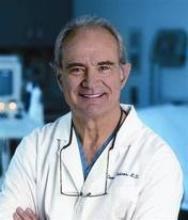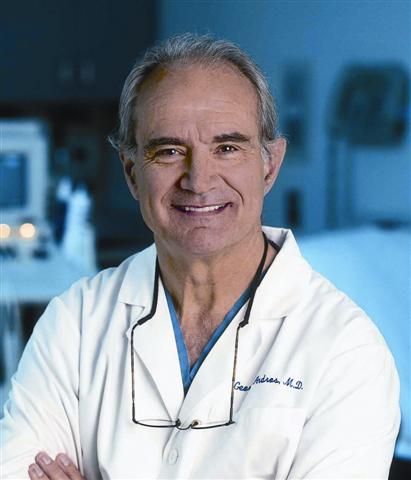User login
This issue's editorial is a calling card by our newest editorial board member, Dr. Joseph Mills of the University of Arizona. Demography is destiny. For a triad of reasons, Southern Arizona is at the epicenter of the global diabetes epidemic. The Arizona vascular surgery group led by Dr. Mills serves Native Americans, Americans of Hispanic heritage, and an increasing number of aging baby boomers and the already elderly that have relocated to or retired in the Sonoran desert.
Within Dr. Mills' patient catchment area is the Tohono O'odham Nation (Pima Indian Community) with perhaps the highest incidence of diabetes of any population in the world. When he talks about diabetic gangrene, he knows whereof he speaks. Recall that more than 80% of non-traumatic major leg amputations occur in diabetics. And diabetics aren't the only groups that have a complex pathogenesis of the foot lesions that lead to amputation.
Age, comorbidities such as renal failure, and multilevel, infrapopliteal and even intrapedal occlusive disease increase the challenge of selecting and performing the best revascularization procedures; remember that you may only get one chance.
Arterial calcification is more pervasive than ever and experienced surgeons are often defeated by it in their revascularization attempts; calcification unquestionably makes everything harder. Anyone who confronts these patients on a regular basis knows how difficult it is to get the feet healed and the patient back to an independent ambulatory life.
Dr. Mills sees the way forward through a better understanding of the interaction of arterial pathology, infection, severity of foot ulceration, patient comorbidities and selection of the right clinical treatment. Short of one or more large-scale prospective randomized trials to perfect our treatment paradigms, Dr. Mills suggests that a well-performed, all-inclusive registry, perhaps via the VQI, may be the best way forward.
I, for one, agree with him.
This issue's editorial is a calling card by our newest editorial board member, Dr. Joseph Mills of the University of Arizona. Demography is destiny. For a triad of reasons, Southern Arizona is at the epicenter of the global diabetes epidemic. The Arizona vascular surgery group led by Dr. Mills serves Native Americans, Americans of Hispanic heritage, and an increasing number of aging baby boomers and the already elderly that have relocated to or retired in the Sonoran desert.
Within Dr. Mills' patient catchment area is the Tohono O'odham Nation (Pima Indian Community) with perhaps the highest incidence of diabetes of any population in the world. When he talks about diabetic gangrene, he knows whereof he speaks. Recall that more than 80% of non-traumatic major leg amputations occur in diabetics. And diabetics aren't the only groups that have a complex pathogenesis of the foot lesions that lead to amputation.
Age, comorbidities such as renal failure, and multilevel, infrapopliteal and even intrapedal occlusive disease increase the challenge of selecting and performing the best revascularization procedures; remember that you may only get one chance.
Arterial calcification is more pervasive than ever and experienced surgeons are often defeated by it in their revascularization attempts; calcification unquestionably makes everything harder. Anyone who confronts these patients on a regular basis knows how difficult it is to get the feet healed and the patient back to an independent ambulatory life.
Dr. Mills sees the way forward through a better understanding of the interaction of arterial pathology, infection, severity of foot ulceration, patient comorbidities and selection of the right clinical treatment. Short of one or more large-scale prospective randomized trials to perfect our treatment paradigms, Dr. Mills suggests that a well-performed, all-inclusive registry, perhaps via the VQI, may be the best way forward.
I, for one, agree with him.
This issue's editorial is a calling card by our newest editorial board member, Dr. Joseph Mills of the University of Arizona. Demography is destiny. For a triad of reasons, Southern Arizona is at the epicenter of the global diabetes epidemic. The Arizona vascular surgery group led by Dr. Mills serves Native Americans, Americans of Hispanic heritage, and an increasing number of aging baby boomers and the already elderly that have relocated to or retired in the Sonoran desert.
Within Dr. Mills' patient catchment area is the Tohono O'odham Nation (Pima Indian Community) with perhaps the highest incidence of diabetes of any population in the world. When he talks about diabetic gangrene, he knows whereof he speaks. Recall that more than 80% of non-traumatic major leg amputations occur in diabetics. And diabetics aren't the only groups that have a complex pathogenesis of the foot lesions that lead to amputation.
Age, comorbidities such as renal failure, and multilevel, infrapopliteal and even intrapedal occlusive disease increase the challenge of selecting and performing the best revascularization procedures; remember that you may only get one chance.
Arterial calcification is more pervasive than ever and experienced surgeons are often defeated by it in their revascularization attempts; calcification unquestionably makes everything harder. Anyone who confronts these patients on a regular basis knows how difficult it is to get the feet healed and the patient back to an independent ambulatory life.
Dr. Mills sees the way forward through a better understanding of the interaction of arterial pathology, infection, severity of foot ulceration, patient comorbidities and selection of the right clinical treatment. Short of one or more large-scale prospective randomized trials to perfect our treatment paradigms, Dr. Mills suggests that a well-performed, all-inclusive registry, perhaps via the VQI, may be the best way forward.
I, for one, agree with him.

